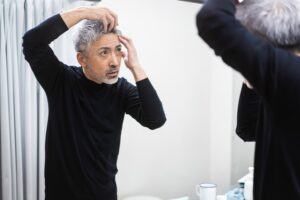 Hair loss can be a frustrating effect of the natural aging process, but that doesn’t mean your days of having thicker, fuller hair are gone for good. Modern approaches to hair restoration are considered much more advanced and effective than hair regrowth techniques of the past, giving patients a wider range of options when it comes to combating their hair loss. Namely, Baltimore patients are now able to choose from both surgical and non-surgical procedures at JEV Plastic Surgery & Medical Aesthetics to catalyze the development of fuller, younger-looking hair.
Hair loss can be a frustrating effect of the natural aging process, but that doesn’t mean your days of having thicker, fuller hair are gone for good. Modern approaches to hair restoration are considered much more advanced and effective than hair regrowth techniques of the past, giving patients a wider range of options when it comes to combating their hair loss. Namely, Baltimore patients are now able to choose from both surgical and non-surgical procedures at JEV Plastic Surgery & Medical Aesthetics to catalyze the development of fuller, younger-looking hair.
The main differences between surgical and non-surgical interventions include the level of invasiveness required by each treatment, the healing period after each procedure, and the quality of the final results. Our award-winning plastic surgeon is an expert in various hair restoration methods and has provided an overview of our various sought-after choices below.
Surgical Hair Restoration
Hair transplants and hairline lowering are two of the most well-known approaches to hair restoration surgery. The former procedure is designed to harvest good-quality hair follicles and transplant them into areas of sparsity. Dr. Houssock is proficient in the traditional strip-harvest method, which involves removing a linear strip of scalp from the donor area; in these cases, she can often minimize scarring with sophisticated donor site closure techniques.* She also proudly offers the advanced Follicular Unit Extraction (FUE) method, which can stimulate hair growth in balding areas without producing an obvious “hair plugs” scar. Alternatively, Dr. Houssock can balance a patient’s facial proportions by lowering their natural hairline.
Patients seeking hair transplantation must have adequate hair growth in the “donor sites,” meaning individuals with depleted donor sites may not be good candidates for FUE hair restoration.
While some healing is required after these surgical modalities, each treatment can provide more immediate and high-quality long-term results than minimally invasive technologies.
Non-Surgical Hair Restoration
On the other hand, non-surgical hair restoration techniques can be ideal for individuals who may not be the best candidates for surgery. At JEV Plastic Surgery & Medical Aesthetics, our non-surgical hair growth treatments include hair restoration with injectables; specialized topical formulas to nourish follicles from within; and medications and supplements, such as finasteride and Nutrafol®, to encourage healthy hair growth.
There is no serious downtime required with these treatments, and patients can typically resume their normal routines right away. That said, those who opt for a non-surgical approach may have to wait relatively longer to see noticeable results when compared to patients who underwent surgery, while supplements and topical treatments usually produce results that appear gradually.
Often, a combination of both surgical and non-surgical techniques provides the best possible results. A consultation with board-certified plastic surgeon Carrie Houssock, MD, FACS, and our team, can help you find an ideal treatment plan for your needs. Contact JEV Plastic Surgery & Medical Aesthetics to learn about the various approaches to hair restoration that may help you achieve your cosmetic goals!
Editor’s note: This blog was originally posted on March 28th, 2022.